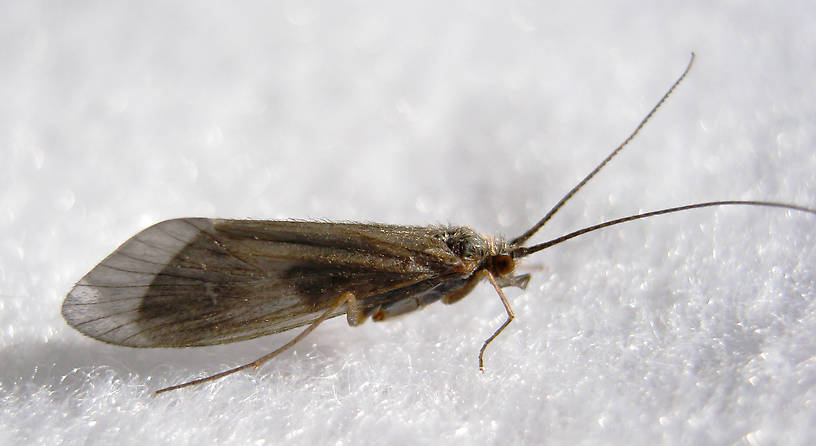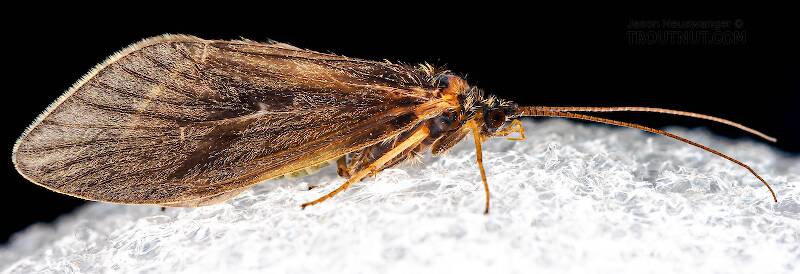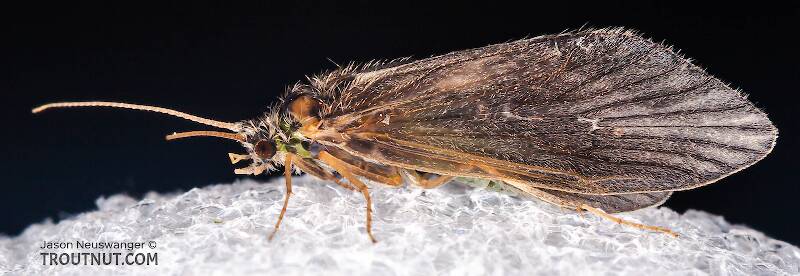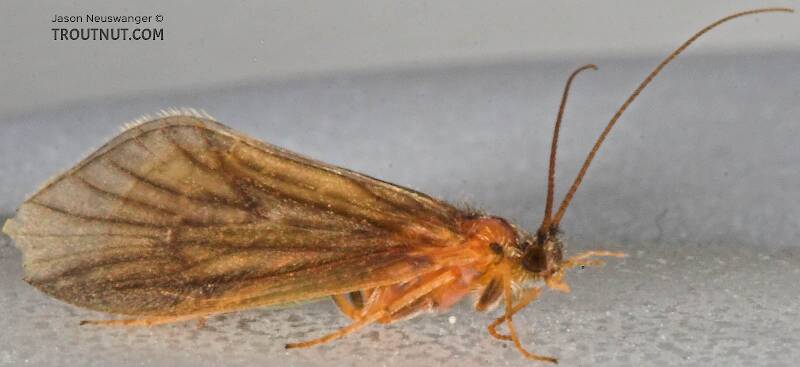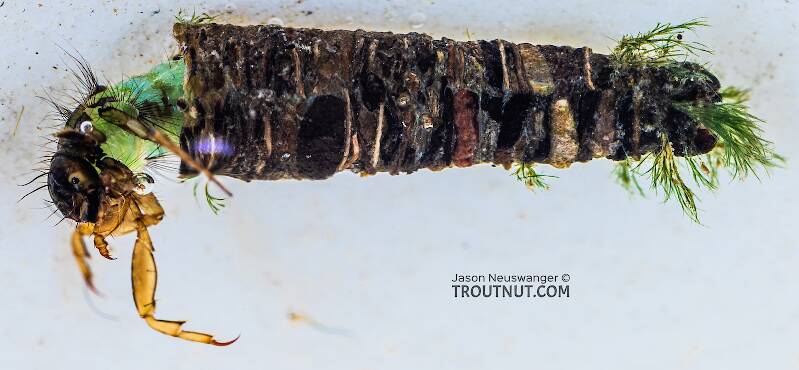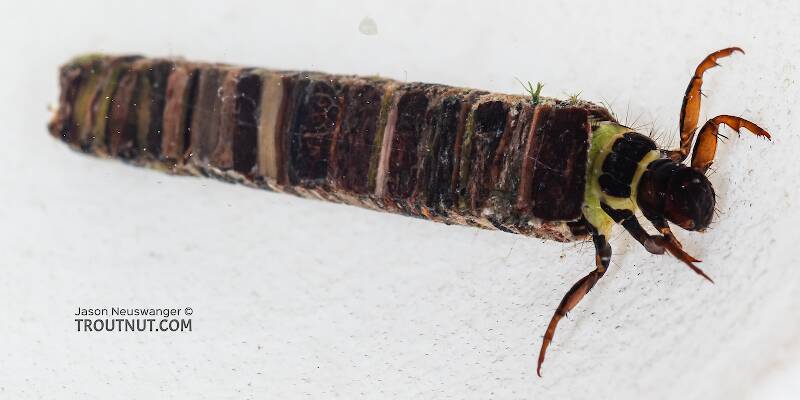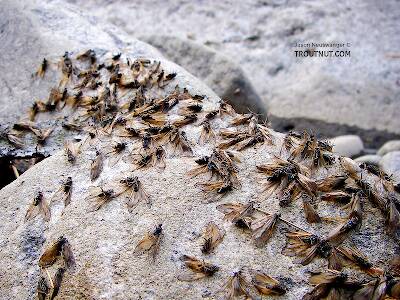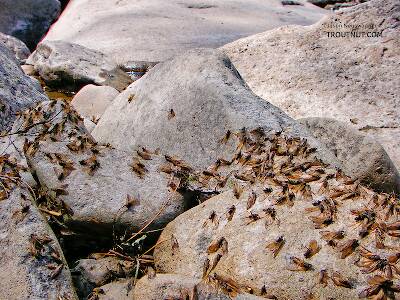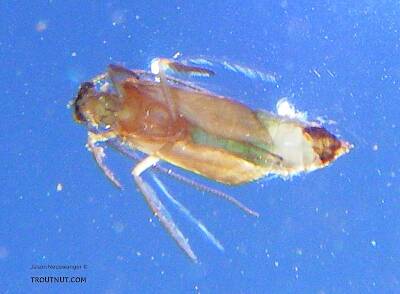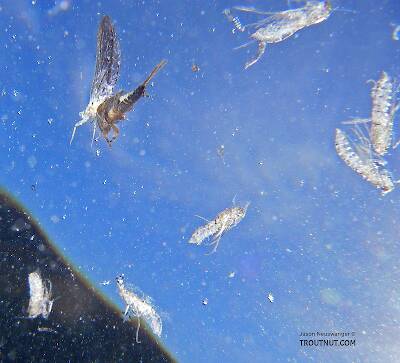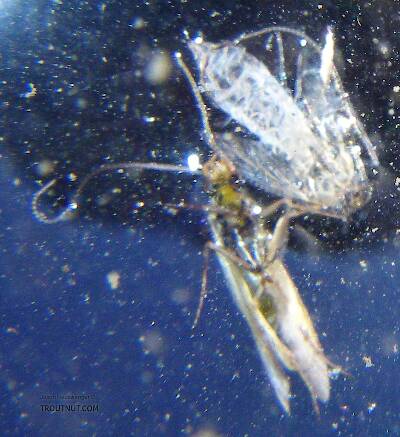
Blue-winged Olives
Baetis
Tiny Baetis mayflies are perhaps the most commonly encountered and imitated by anglers on all American trout streams due to their great abundance, widespread distribution, and trout-friendly emergence habits.
Featured on the forum

I caught this tiny larva without a case, but it seems to key pretty clearly to to Glossosomatidae. From there, the lack of sclerites on the mesonotum points to either Glossosoma or Anagapetus. Although it's difficult to see in a 2D image from the microscope, it's pretty clear in the live 3D view that the pronotum is only excised about 1/3 of its length to accommodate the forecoxa, not 2/3, which points to Glossosoma at Couplet 5 of the Key to Genera of Glossosomatidae Larvae.

Troutnut is a project started in 2003 by salmonid ecologist Jason "Troutnut" Neuswanger to help anglers and
fly tyers unabashedly embrace the entomological side of the sport. Learn more about Troutnut or
support the project for an enhanced experience here.
Caddisfly Genus Brachycentrus (Grannoms)
This prolific genus includes the popular eastern early-season Apple Caddis and Grannom hatches. Their life cycles are ideal for the fly angler, and every stage is frequent trout prey.
Note that this species changes color dramatically after it emerges, and imitations of egg-laying adults should be a different color from imitations of emergers. Emergers have pale blonde, almost off-white wings and bright green bodies, while the egg-laying adults have light brownish gray wings and medium green bodies.
Note that this species changes color dramatically after it emerges, and imitations of egg-laying adults should be a different color from imitations of emergers. Emergers have pale blonde, almost off-white wings and bright green bodies, while the egg-laying adults have light brownish gray wings and medium green bodies.
Where & when
In 189 records from GBIF, adults of this genus have mostly been collected during June (25%), May (19%), July (18%), April (15%), August (12%), and September (6%).
In 140 records from GBIF, this genus has been collected at elevations ranging from 3 to 19029 ft, with an average (median) of 5659 ft.
Genus Range
Hatching behavior
Most Brachycentrus species have very brief, very intense emergences on which trout feed steadily. Brachycentrus americanus is an exception, as its emergence may be more spread out.The pupae are vulnerable to trout during their lengthy surface emergence.
Egg-Laying behavior
Brachycentrus adult females land on and ride the water calmly to oviposit, so they are well-imitated with traditional tent-wing caddisfly patterns.Larva & pupa biology
Diet: Algae, plankton
Shelter type: Tapered wood cases of rectangular cross-section
Special thanks to Lloyd Gonzales, author of the excellent new book Fly-Fishing Pressured Water, for helping to sort out the Brachycentrus species and common names.
Specimens of the Caddisfly Genus Brachycentrus
1 Female Adult
3 Adults
1 Pupa
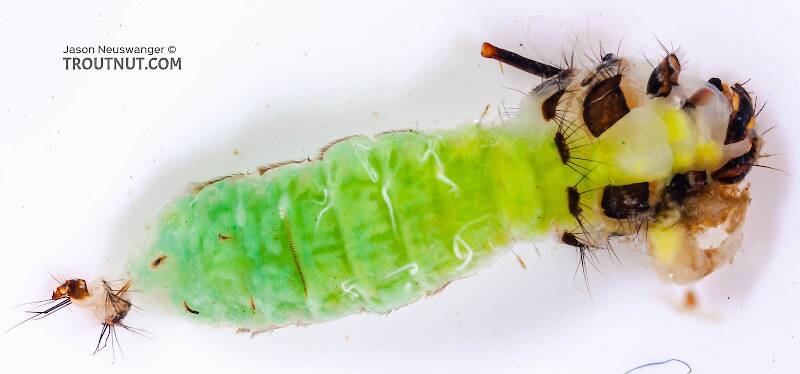
The green blob contained in this case is a pupa in the early stages of transformation from larva to the final stage we generally picture and imitate. This specimen and several like it were fixed to a rock I picked up, and each one had the front of its case sealed off, protecting the helpless pupa from predation. It's neat to see the insect part-way through such a radical transformation.
It was very hard to extract this thing from its case, so there's a bit of extra goo near the head from where I accidentally punctured it.
It was very hard to extract this thing from its case, so there's a bit of extra goo near the head from where I accidentally punctured it.
2 Larvae
2 Streamside Pictures of Brachycentrus Caddisflies:
3 Underwater Pictures of Brachycentrus Caddisflies:
Discussions of Brachycentrus
Brachycentrus americanus on the Lower Sacramento River California
Posted by Troutguide on Oct 29, 2016 in the species Brachycentrus americanus
Last reply on Oct 29, 2016 by Troutguide
I believe this is the species found in sometimes very large numbers on the Lower Sacramento River in the Redding area. Ten years ago it was present in such large numbers that fishing a fly on the bottom resulted in frequently hooking one of these caddis still in its case. Along with other aquatic insects their numbers have declined to a fraction of once seen. I don't believe the egg Sac dropped by the females to be olive , instread I have seen it to be a bright green. The females seem to oviposit close to the edge of flowing water and not midstream.
grannom caddis
56 replies
Posted by Goose on Sep 26, 2006
Last reply on Feb 1, 2016 by Martinlf
Hi All! I was reading through the site and I happened upon the Grannom (Apple) Caddis page, which made me wonder. Here in PA it is called The Mother's Day Caddis, I believe. Adults, which trout rarely feed on, are imitated with black or peacock herl bodies. The pupa, or emrgers I guess, we imitate with a wet fly. It has a peacock herl body and brown hackle for the legs, etc. in a size 14. Is this the same Grannon as the apple Grannom? Just curious!
I still get confused by these caddis and I'm trying to narrow down a list of caddis patterns and colors to cover the largest percentage of the hatches throughout the year.
I still get confused by these caddis and I'm trying to narrow down a list of caddis patterns and colors to cover the largest percentage of the hatches throughout the year.
What's happening here?
5 replies
Posted by Troutnut on Jun 5, 2007
Last reply on Jun 6, 2007 by Troutnut
Check out the two streamside pictures on my Brachycentrus page. I found these clusters of dead grannoms in a few different spots along a Catskill river on May 12th, while many members of (seemingly) the same species were in the air laying eggs and occasionally falling spent and being eaten by trout.
Have you ever seen these clusters? What's the explanation?
Have you ever seen these clusters? What's the explanation?
Start a Discussion of Brachycentrus
References
- Gonzales, Lloyd. 2005. Fly-Fishing Pressured Water. Stackpole Books.
- LaFontaine, Gary. 1981. Caddisflies. The Lyons Press.
- Schwiebert, Ernest G. 1955. Matching the Hatch. MacMillan Publishing Company.
- Swisher, Doug and Carl Richards. 2000. Selective Trout. The Lyons Press.
Caddisfly Genus Brachycentrus (Grannoms)
Taxonomy
Species in Brachycentrus
Brachycentrus americanusAmerican Grannoms
3
32
Brachycentrus appalachiaApple Caddisflies
3
30
Brachycentrus fuliginosus
0
0
Brachycentrus lateralisStriped Grannoms
0
0
Brachycentrus nigrosomaDark Grannoms
0
0
Brachycentrus numerosusDark Grannoms
0
0
Brachycentrus occidentalisMother's Day Caddisflies
0
0
Species in Brachycentrus: Brachycentrus americanus, Brachycentrus appalachia, Brachycentrus fuliginosus, Brachycentrus lateralis, Brachycentrus nigrosoma, Brachycentrus numerosus, Brachycentrus occidentalis
7 species (Brachycentrus chelatus, Brachycentrus echo, Brachycentrus etowahensis, Brachycentrus incanus, Brachycentrus signata, Brachycentrus solomoni, and Brachycentrus spinea) aren't included.


